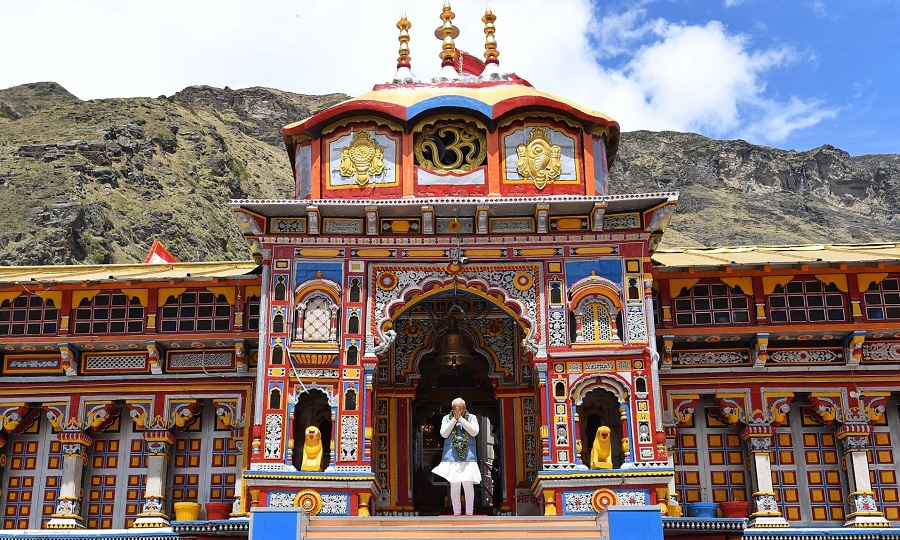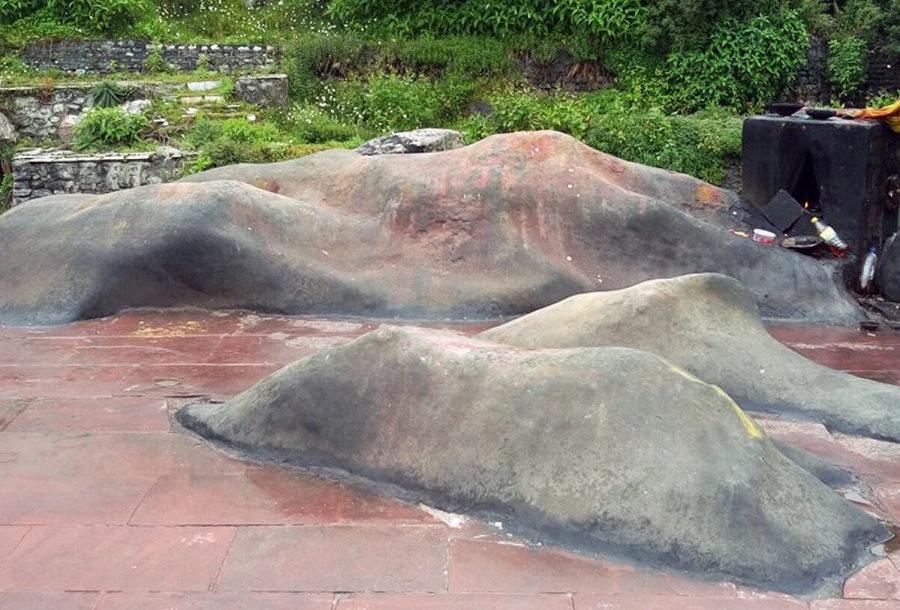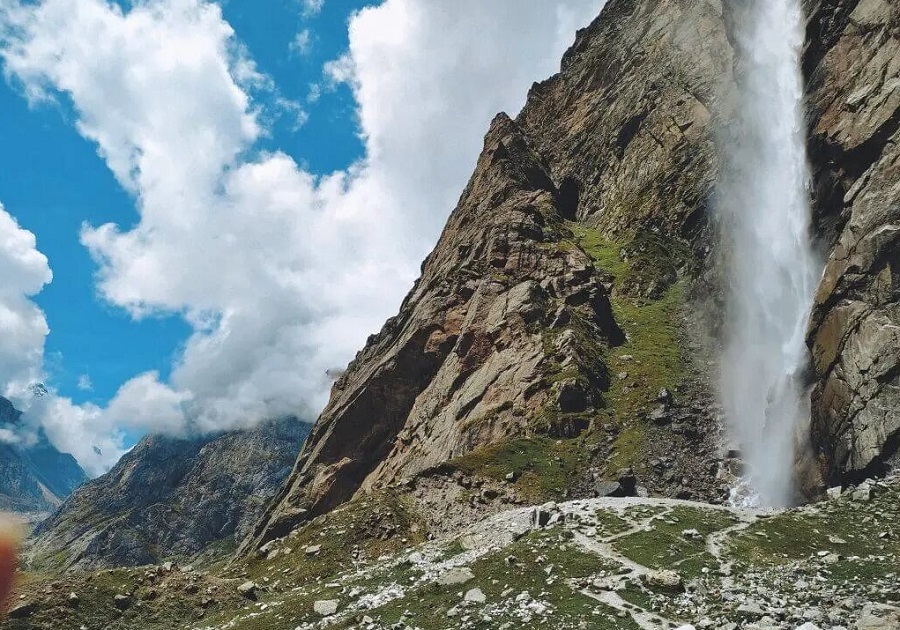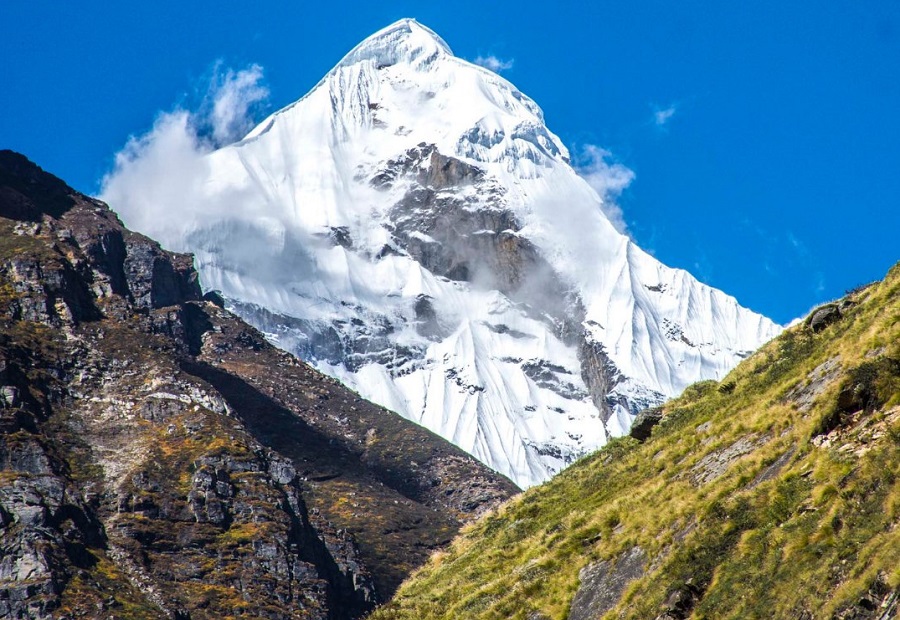Badrinath Dham is surrounded by the Nar and Narayan mountain ranges. It is one of the Char Dhams, along with Dwarka, Puri, and Rameshwaram, and is one of India's most revered pilgrimage sites. The Alaknanda River flanks this pilgrimage site, which has a beautiful backdrop of the Neelkanth mountain peak. Badrinath Dham is dedicated to Lord Vishnu, who is revered as the protector of the universe. The Garhwal kings built it around two centuries ago. Later, Adi Guru Shankaracharya founded and restored it. Lord Vishnu in a meditative posture is the main idol, but there are also images of Goddess Laxmi, Garud (Vishnu's mount), Lord Shiva, Parvati, and Ganesha. The road to Badrinath Temple is very convenient. It is, however, snow-covered for nearly six months. Take a look at the guide to help you plan the best Badrinath Yatra possible.
The Legend - Historical Impact
Sri Adi Shankaracharya, according to legend, re-established Badrinath, also known as Badri Vishal, to restore Hinduism's lost prestige and to unite the nation in one bond. Badrinath is a sacred land steeped in stories from various ancient Hindu scriptures. The puranic story of the Pandav brothers and Draupadi passing through on their last pilgrimage by ascending the slopes of Swargarohini, a peak near Badrinath, or the 'Ascent to Heaven,' or the visit by Lord Krishna and other great sages are just a few of the many stories associated with this holy Tirtha. While many stories surround the Badrinath temple, the most well-known is the origin of its name. In Hindi, the word 'Badri' refers to a type of wild berry. When Lord Vishnu goes to the mountains for penance, Goddess Laxmi appears as a berry tree, protecting Lord Vishnu from the threatening environment.
Best Time To Visit - Weather Forecast
Badrinath, a small but magnificent holy town in Uttarakhand, gave us a glimpse of its grandeur before closing its doors again. During the cold winters, the Badrinath temple, its crown jewel, is closed. The best time to visit Badrinath is during the summer, when the temple is at its most beautiful. However, Badrinath remains cold and snowy for the majority of the year. An average temperature of 18 degrees Celsius is generally pleasant and comfortable. Temperatures drop as Monsoon and winter arrive, icing Badrinath with a patter of raindrops and then a sprinkling of snowflakes. While your choices for suitability and safety may be limited, a trip to Badrinath is an absolute must. It is a town that not only hosts the annual Char Dam festival, but it also exudes spirituality through nature. Don't blame the altitude for making you short of breath. Natural wonder, serenity, and beauty will steal your heart, soothe your soul, and delight your senses.
Weather - April to June
Temperature - Summer temperatures in Badrinath range from 29 degrees high to 19 degrees low.
Weather: In the summer, the sun appears to bless the weather in Badrinath. Despite temperatures as low as 8°C, the summer weather in Badrinath is generally pleasant. Summer is an ideal time to visit Badrinath and its surroundings. The heat from the sun keeps the area warm, and the lack of snow makes travel much easier and safer.
Significance: This is the season for the well-known Char Dham Yatra. The yatra is open from April to May and includes four major stops, the last of which is Badrinath. From April to October, pilgrims can visit Badrinath. When you combine this fact with the pleasant weather of summer, it's easy to see why Badrinath sees the most visitors during this season.
Why you should visit now: Summer in Badrinath is heaven on earth, with clear skies, warm days, and beautiful landscapes to explore. Because you won't be snowed in or restricted by rain like in other seasons, this is the best time to visit Badrinath. Furthermore, you can share the spirituality of the temple, the yatra, or your pilgrimage with others who have come to worship at Badrinath.
Things you should know before you visit: Don't be fooled by Badrinath's summer sun. The nights here can be chilly, so bring some woollens and sweaters to keep warm.
Tips: Because of the Char Dham yatra, this is peak season in Badrinath. Devotees from all over the country, and even the world, travel to Badrinath to renew their faith and enjoy the spiritual and natural beauty of the area. Booking tickets and hotels can be difficult if you do not plan ahead of time.
Weather - July to September
Temperature: During the monsoon, the temperature in Badrinath ranges from 27 degrees high to 20 degrees low.
Weather: Cold and chilly days characterise the monsoon season in Badrinath. Although the monsoon season is ideal for exploring the region, it does have one drawback: rain. Monsoon showers range from moderate to heavy in Badrinath, making sightseeing difficult. The rainiest months are July and August, with the droplets drying up to a large extent by September?
Significance: Badrinath reopens to tourists in September, and you can join the holy pilgrimage. September is also one of the last months when the Badrinath temple is open. As a result, the window for visiting the temple for Darshan is quite limited, and it must be done before winter arrives and the snow drifts in.
Why you should visit now: With a large number of devotees and tourists visiting, September is the busiest month in Badrinath. By mid-September, the rain will have stopped, and you'll be able to enjoy the occasional shower. It enhances the beauty of the area while not impeding your movement.
Things to know before you visit: Before planning consider the monsoon season, whether it is heavy or moderate. Few tourists or pilgrims visit Badrinath between June and August although there are high risk of landslides in this area during the monsoon. Always keep an eye on the weather. In addition, if you're looking for snow this time of year, the higher mountain slopes will have it.
Tips: If you decide to go, bring a raincoat, gumboots or trekking shoes, woollen clothing, a windcheater, thick socks, waterproof gloves, and other items to protect yourself from the soaking rain and chilly weather.
Weather - October to April
Temperature: Badrinath has mixed weather with a hint of winter, a little rain and slow snowflakes with a minus degree of 6 in the air.
Weather: While September and early October are mostly dry and snow-free, the first snowflakes fall in mid-October. By the end of October, Badrinath is covered in a thick white blanket of snow. Roads to the town are closed due to the extreme weather, and snow will continue to fall on Badrinath until mid-March or early April.
Significance: In this section, we would normally describe the events and festivals that take place during this season. In the winter, however, the weather in Badrinath effectively blocks the world outside, transforming the town into a silent, secluded, and snowed-in town. With the temple closed for the next six months and snow covering everything, a winter trip to Badrinath is not possible.
Things to know before you visit: Temperatures drop to sub-zero levels, making the entire area uninviting to tourists.
Tips: Given the foregoing, it makes sense to wait until April before reopening Badrinath. During the winter, the region enjoys its own form of rest and recuperation before the yatra begins.
Top Tourist Destinations near Badrinath Temple
Brahma Kapal
Brahma Kapal is a sacred Ghat located on the banks of the Alaknanda River in Badrinath Town, 1 km from the Badrinath Bus Stand. Brahma Kapal is a flat platform where Hindus perform rituals, pay homage to departed souls, and offer Shraddha to their ancestors. It is said that Lord Brahma exists here, and that if a person performs Rituals and Shraddha Karma for his family's departed souls, he will be freed from the cycle of birth and death. It's only a hundred metres north of the Badrinath Temple. Lord Shiva, according to Brahma Kapal, was released from his curse of killing Brahma at this location. Here at Brahma Kapal, Brahma's head is also said to have fallen off Shiva's trident. Sheshnetra, Charanpaduka, and the Mata Murthy Temple are all nearby religious sites.
Vyas Gufa
Vyas Cave is an ancient cave located in Mana village, Chamoli district, Uttarakhand, 5.5 kilometres from Badrinath Bus Stand on the banks of the Saraswati River. It is believed to be the site where Sage Vyas wrote the Mahabharata epic with the help of Lord Ganesha. He also composed 18 Puranas, Brahma Sutras, and four Vedas. The roof of the temple is notable for resembling pages from his holy scripts collection. In addition, the location has an intriguing backstory that explains Lord Ganesh's broken tusk. Vyas needed someone to take his dictation while writing the Mahabharata, so he enlisted the help of the learned Ganesha. Ganesh agreed on the condition that Vyas not stop writing for even a single second, or else he would stop and leave. Vyas dictated as quickly as he could, while Ganesh bent over the script pages. He cut a piece of his tusk to use as a pen after his reed pen broke. Ganesha cave is also close by, located beneath Vyas cave. A natural rock known as Bhim pul rests over the river near this temple.
Charan Paduka
Charanpaduka, also known as Charan Paduka, is a beautiful rock 3 kilometres from Badrinath that is said to have Lord Vishnu's footprints. Viewing these footprints is said to cure visitors of all ailments. The Charan Paduka is located 3,380 feet above sea level. Lord Vishnu first set foot on Earth here, according to Hindu mythology. Lord Sri Krishna advised his minister Uddhav to go to Badrinath with his Charan Paduka to atone for his wrongdoings, according to the Bhagwat Purana. A 3-kilometer trek from Badrinath leads to Charan Paduka. The Charan Paduka path is on the left side of the Badrinath temple. After a few metres, you will notice stairs leading upwards on the right side. Continue up the stairs to Narayan Parvat's Charan Paduka. The three-kilometer ascent to Charan Paduka takes about 1.5 hours. The view from Charan Paduka is spectacular. Neelkanth Peak is on one side, and Nar Parvat is on the other. On Charan Paduka's left bank, Rishi Ganga flows through a man-made diversion to form a waterfall. The road leading to Charanpaduka is riddled with caves and boulders. The Badrinath shrine board's medical unit is housed in the rock. This medical unit is well-equipped and stocked with all necessary medical supplies.
Tapta Kund
Tapt Kund is a natural hot water spring near the Badrinath Temple in Badrinath town. Tapt Kund, Lord Agni's abode, is well-known for its medicinal properties. Before entering the Badrinath Temple, a holy dip in the Tapt Kund is required. Kund's water temperature is 45° Celsius, and there are numerous hot water springs on the Alaknanda River's banks. All skin diseases are thought to be cured by bathing in a hot spring. Below Tapt Kund is Narad Kund, where Adi Shankaracharya is said to have discovered the current image of Badrinarayan. Because the Kund is considered sacred, pilgrims rarely bathe here. Devotees regard the five large stone rocks known as Panch Shilas that surround the Kund area as sacred. Narad Shila is located next to Tapt Kund and is said to have been home to Bhakta Narad, a great devotee of Lord Vishnu. Garud Shila is on the path that leads from the Kund to the temple. Narasimha Shila, Varahi Shila, and Markandeya Shila are hidden beneath the Alaknanda waters.
Mana Village
Mana village is a charming little hamlet on the Indo-Tibetan border in Uttarakhand's Chamoli district. This is India's final village before the Indo-Tibet border. It is located on the banks of the Saraswati River, which flows from a mountain near Mana Village. It is home to the Indo-Mongolian tribe of the Bhotias. The village has approximately 180 households and a population of approximately 600 people. The Badrinath temple and the annual Mata Murti Fair have cultural significance for the villagers. On the last day of the temple, they perform an annual ritual by offering a Choli to the deity. They come and live here for six months when the Badrinath temple reopens in April/May to preserve their tribe's culture and traditions. They live in Chamoli for the rest of the year. Vyas Cave is one of several caves in the village of Mana. Lord Ganesh is said to have dictated his famous Mahabharata to Veda Vyas here. Ganesh Gufa is another cave near Vyas Cave. Bhim Pul is a natural rock that protrudes into the river. Bhima, one of the five Pandavas, is said to have placed the rock to allow Draupadi to cross the river during their Swargarohana.
Vasudhara Falls
Vasudhara Falls, located near Badrinath, is a popular tourist destination. It's a popular short trekking route near Badrinath. Vasudhara Falls is surrounded by breathtaking mountain ranges. This cascading waterfall's water falls from a height of 400 feet and is located at an elevation of 12,000 feet. The falls are thought to be haunted. According to legend, the water of Vasudhara Falls repels visitors who are not pure at heart. The water of the fall appears to be milk flowing down the mountain from a distance. Visitors must trek 6 kilometres from Mana village to reach the falls. The one-way trek from Mana to Vasudhara takes about two hours. The first 2-3 kilometres are relatively easy to walk. The trek becomes difficult after passing the Saraswati Mandir, as the trail becomes very steep. The views of the Vasudhara river valley from this trek are spectacular. A bath under falling water is both refreshing and exciting. From here, one can see the Chaukhamba, Nilkantha, and Balakun Mountains.
Neelkanth Peak
Nilkantha is a snowy pyramid-shaped peak near Badrinath in Uttarakhand's Chamoli district. The mountain's elevation is 6,597 metres above sea level. It is one of the most beautiful trekking routes in Uttarakhand. Lord Shiva inspired the name Neelkantha, also known as the Garhwal Queen. From afar, the peak resembles Lord Shiva in meditation. It receives the first rays of sunlight that illuminate the valley. Nilkantha is a major peak in the Uttarakhand region of the Garhwal Himalayas. Despite being significantly lower than the region's highest peaks, it towers dramatically over the Alaknanda River valley. The Satopanth Glacier is on Nilkantha's northwest side, while the Panpatia Glacier is on the southwest side and feeds Khirao Ganga, a small stream that runs beneath the peak on the south side. Mt. Neelkanth has had few successful ascents; two British climbers made the first attempt from its western ridge in 1993. The best time to visit Neelkanth Peak is from June to September. In Badrinath, the 10-kilometer Neelkanth Trek begins. The three-kilometer trek from Badrinath to Charan Paduka is breathtaking, and visitors can see Lord Vishnu's footprints as well as Rishi Ganga Falls.
Important Tips While Planning Badrinath Visit
- Respect the environment and refrain from engaging in activities that may offend pilgrims. This includes consuming alcoholic beverages, smoking, and eating non-vegetarian foods.
- The journey from Kedarnath to Badrinath is not as difficult. Dizziness, on the other hand, is completely normal due to the low oxygen levels in the air. As a result, ensure that you are adequately acclimatised and capable of completing the climb.
- Put on a conservative outfit. This is a pilgrimage that all Hindus hold in high regard. As a result, make certain that you are not offending anyone here - the location is very important to its visitors.
- Photography is not permitted in the temple. Please follow the instructions of all temple officials.
- Travel should be avoided during the monsoon season. If you're familiar with the area, you'll know how difficult the rains can be. Then you should avoid it. It is best to visit early in the season or after the monsoon.
Route Map
Haridwar To Rishikesh then further to Devprayag to Kirtinagar to Srinagar, further travel to Rudraprayag then to Gauchar to Karnaprayag to Nandprayag then to Chamoli (Chamomile) to Birahi (Birahi) then Pipalkoti move ahead to Garur Ganga to Helang then to Joshimath then Vishnuprayag move on to Govindghat then to Pandukeshwar then Hanuman Chatti (Hanumanchatti) and finally to Shri Badrinath Ji.
How to Reach Badrinath
Train Service
The railway network connects you to Haridwar. A number of train routes connect Haridwar, Rishikesh, and Dehradun. When you arrive in Haridwar, you can easily take any local mode of transportation to your destination, such as a bus, taxi, or cab. Traveling by train takes time, but it is undeniably cost effective.
Air Service
You can use air transportation to get to Badrinath. Dehradun has a well-known airport called Jolly Grant Airport. After arriving at the mentioned airport, you can take helicopters to Badrinath for your convenience. Air services take less time to reach Badrinath but are more expensive than train services.
You can also travel by helicopter for a more personalized experience; simply book through Badrinath Yatra by helicopter and enjoy your divine journey.
Rental Self-drive car
You can also rent self-driving cars. If you want to enjoy pleasant cool weather and scenery while travelling with your family, self-drive cars are the way to go. Check out the best deals on self-drive cars for rent before making a decision.











